Rosacea - Patients ask, Dr. Ringpfeil answers
Please feel free to use the blog below to share information about Rosacea or to ask Dr. Franziska Ringpfeil a question that might be of interest to others.
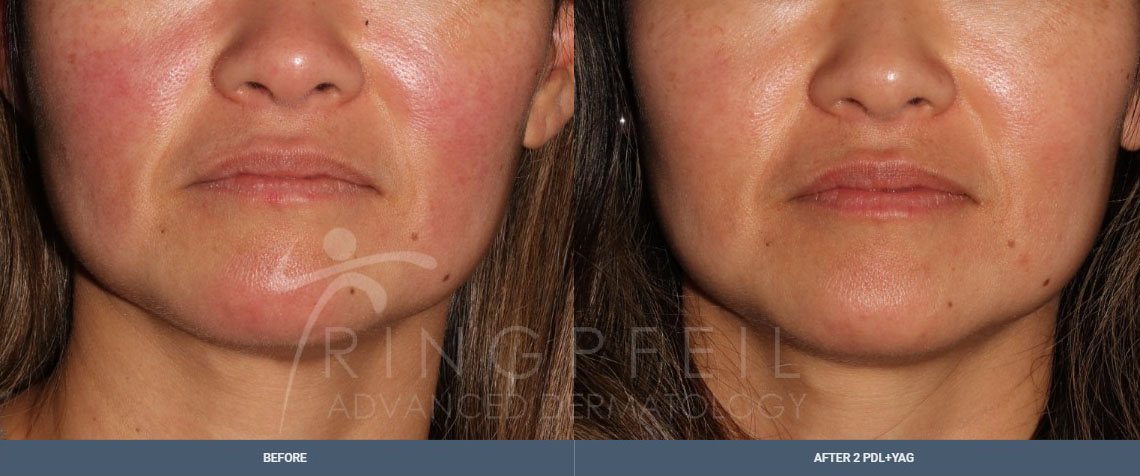
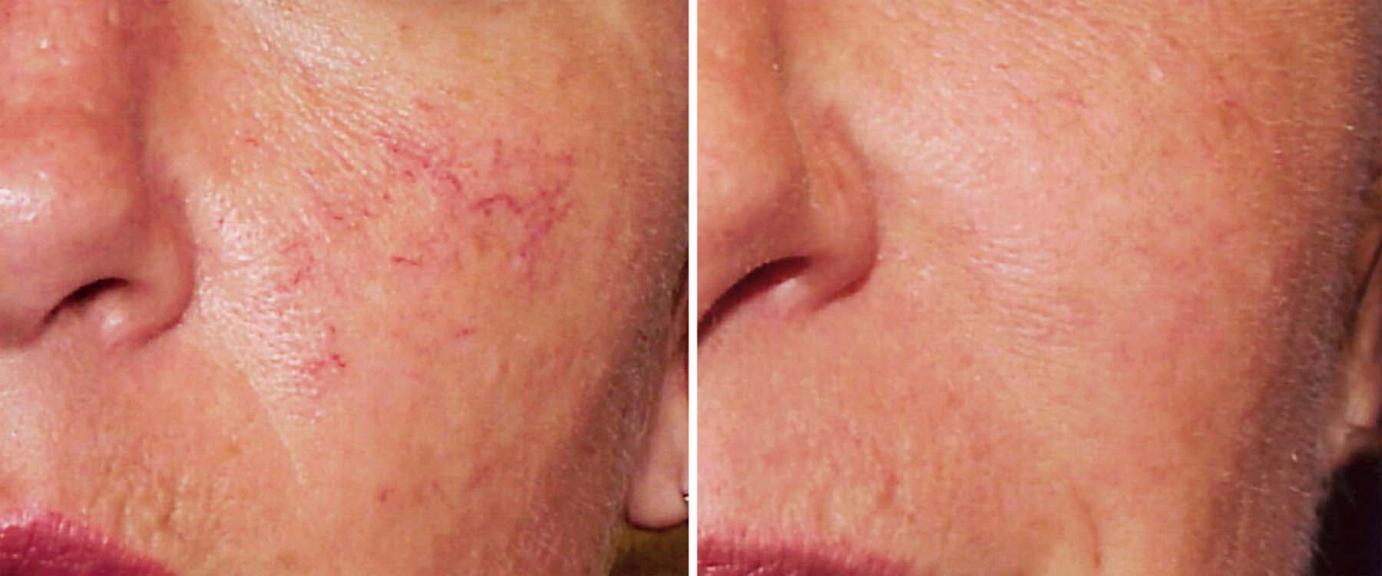
Treatments:a topical and oral medication, PDL (VBeam), photodynamic therapy, CO2 laser therapy.
Most individuals with rosacea experience blushing or flushing over the central face with trigger factors such as sun exposure, drinking hot beverages or alcohol, or eating spicy food. Persistent central facial redness is often present. The underlying enlarged vessels can very efficiently be treated by vascular lasers, greatly improving background redness as well as diminishing flushing with rosacea triggers.
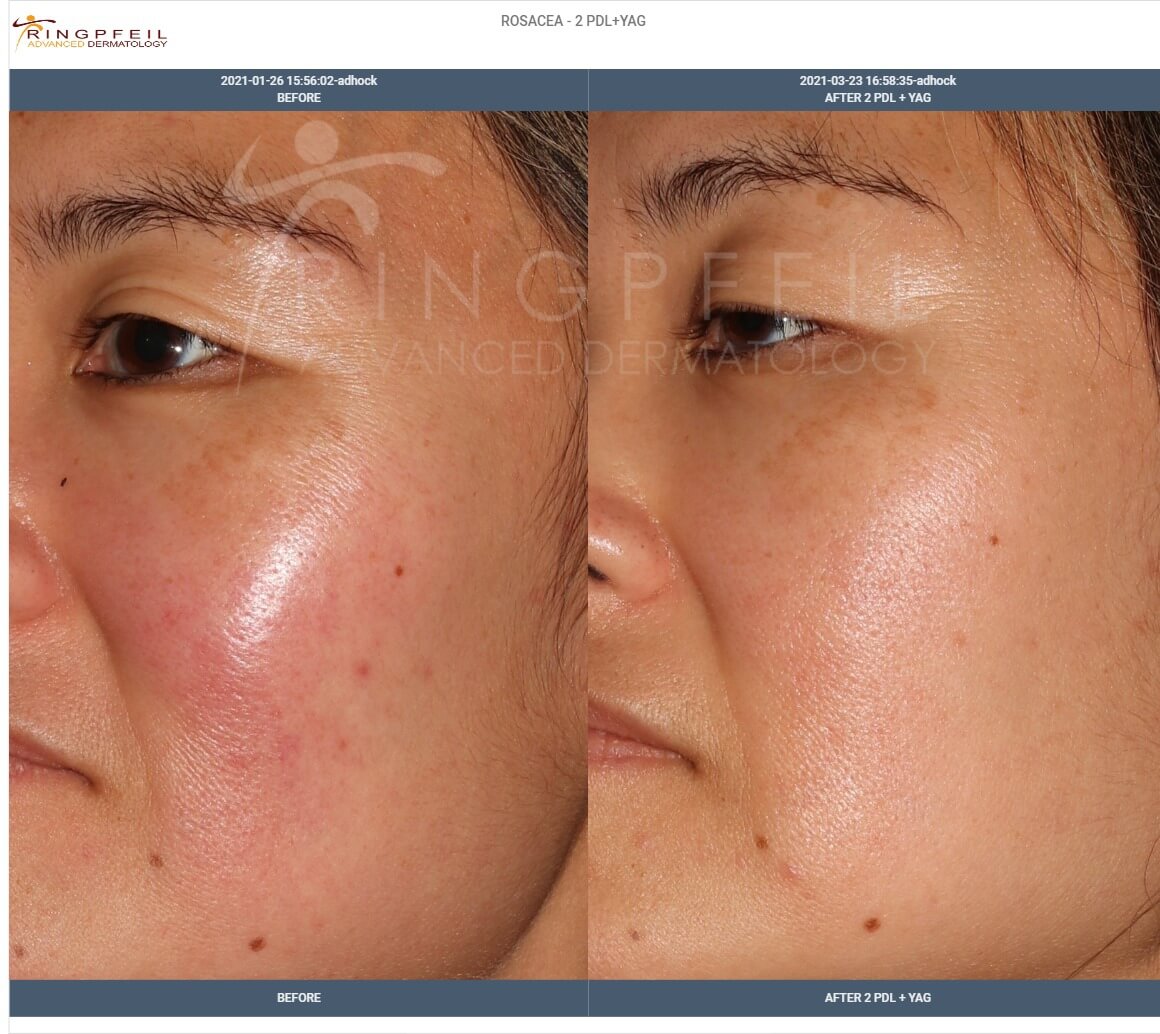
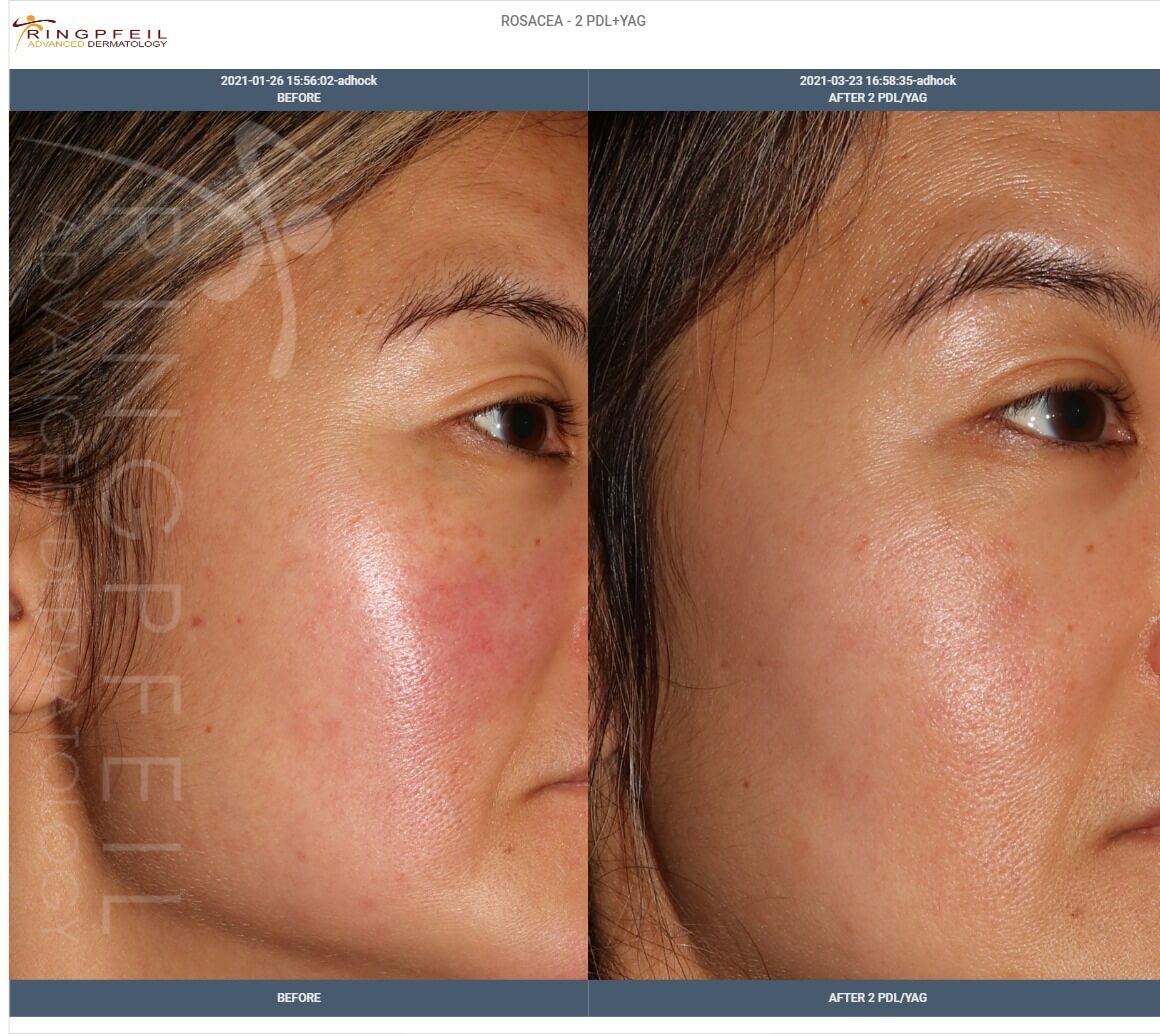
Inflammatory rosacea presents with red papules or pustules and requires topical or oral anti-inflammatory agents, or when recalcitrant, photodynamic therapy. Men may develop an overgrowth of tissue on the nose in response to long-standing rosacea that can be corrected by CO2 laser ablation.
Ocular rosacea may be misdiagnosed if rosacea does not affect the skin. Oral anti-inflammatory antibiotics may be crucial to prevent the possible destruction of eyesight.
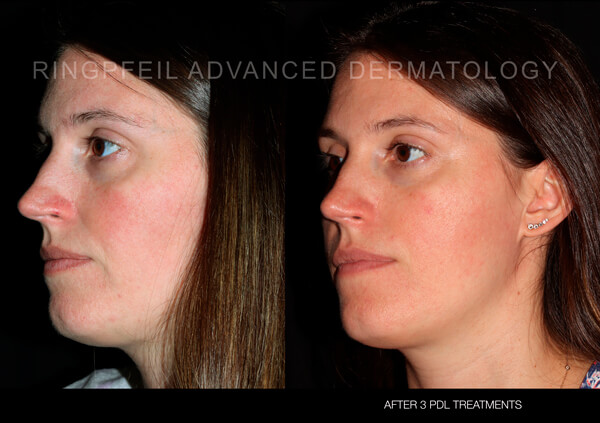
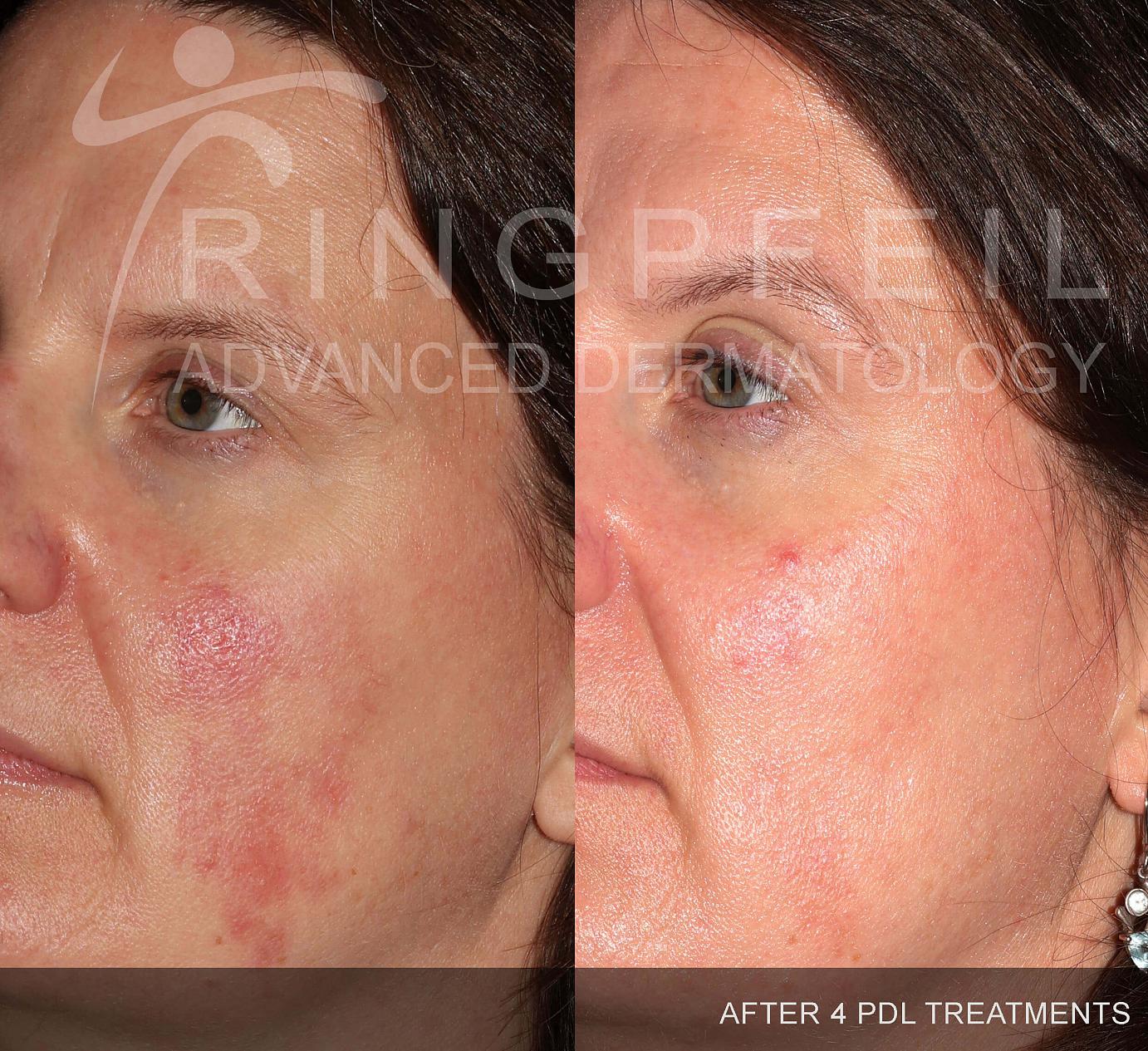

Hello! Ive had rosacea for years and have tried several drs and every treatment. I have constant redness and have itchy bumps/blotchiness during flare ups. During our visit last year you suggested PDL or IPL. My symptoms have gotten progressively worse and I think Im finally ready to go to this extreme. (A) Is one treatment better than the other (PDL v IPL)? (B) In your experience does insurance ever cover these treatments? Thanks so much 🙂
Redness due to widened blood vessels in rosacea is a very common problem.
About 85% of all people with rosacea have variable degrees of baseline redness that only becomes more showy with triggers like sun exposure, caffeine, spicy food, hot beverages or red wine.
The most efficient treatment for this redness is the pulsed dye laser (PDL).
Between 2-4 treatments 4-6 weeks apart are needed. Additional laser induced redness typically lasts for up to 24 hours after each treatment but swelling can last for up to one week. Bruising is rare. Sun protection is paramount for 4 weeks after each treatment but should be continued to maintain results. These usually last 5-10 years. PDL treatments can be repeated.
In contrast, intense pulsed light (IPL) is a non-laser light source that quickly reduces redness with rosacea. It is a nice choice when you quickly need to look better. The effects last for several weeks and IPL can then be repeated as needed or every 2 months to maintain results. It is not my preferred choice because most people with rosacea are looking for long term results. Considering that the cost per treatment is the same, PDL is much more cost effective.
Franziska Ringpfeil, MD
I would like to know the cost per treatment and how many treatments are needed .. I only need it done on a portion of my forehead. Thanks Mike
The removal of showy redness from enlarged blood vessels is most efficient with a pulsed dye laser. Widened blood vessels in rosacea typically affect almost the entire face including central cheeks, nose, chin and lower forehead. Typically, up to 4 treatments are needed spaced 4-6 weeks apart.
Cost per treatment is $400. It is unusual to have rosacea localized only on the forehead. Not all widened blood vessels (telangiectasias) suggest rosacea. Telangiectasias can occur independent of rosacea. They often require less than 4 treatments and the charge is $105 for the first spot and $20 for each additional spot per treatment. Complimentary consultation with our aesthetician is available and exact diagnosis, treatment plan and pricing will be discussed.
Hi Dr.,
I have had rosacea for a number of years. It wasn’t a severe case, but approx. 5 years ago I went to a Plastic Surgeon and after consultation, I agreed to IPL.
If memory serves me correctly I had about 6 or 7 sessions and it was effective. I was very pleased with the results. The Dr. had advised me in order to maintain the results I should come back once a year and have one session of IPL.
So, for the past few years I went back for the session. Again, I was pleased with the results.
About 2 weeks ago, I went in for my yearly session, and the Dr. advised he had a newer and better procedure. I think it was called Limelight, but I’m not 100% sure. The procedure was similiar. They applied a gel on my face which was on for an hour. Then, he came in with some type of heat wand and went around my face. The last application was the laser which stung alot more than previous years. The previous sessions the laser felt as though someone was hitting my face with a rubberband. This session it really really stung.
After the session was complete, I noticed two bruises/swelling. One was on my forehead, and the other was on the right side of my face and it was in my hair line. I remember looking at the bruise/swelling around my hairline, and I remember thinking that doesnt look good, and I wonder if my hair will fall out in that place.
About a week later the swelling/bruises went away. I cut my hair and I cut it somewhat close on the sides.
The next morning, when I awoke, I noticed an oval shaped bald spot on my hairline exactly where the laser struck it and caused the bruise. It looks very unussual. I’ve had it now for about 5 days and I dont believe I have grown any hair back in that spot, at least not yet.
I guess I have a few questions and I’m not sure if your going to be able to answer them. The 1st one, is in describing that the laser struck the hairline causing a bruise is it normal that the hair in that location fell out. Did the laser damage the hair follicle. Is the hair ever going to grow back there.
Thank-You
The questions are very specific and must be directed at your treating physician. Without evaluation of your skin and hair and knowing with certainty the name of the method used, I am unqualified to render any judgment.
Franziska Ringpfeil, MD
The questions are very specific and must be directed at your treating physician. Without evaluation of your skin and hair and knowing with certainty the name of the method used, I am unqualified to render any judgment.
Franziska Ringpfeil, MD
How do you feel about medications such at erythromycin (antibiotic) to reduce itching and burning sensation due to rosacea. When I have a flare-up, I am itchy all over my body.Thanks
Personal feelings aside, erythromycin may work for your symptoms but there is currently not enough scientific evidence to support erythromycin as an anti-itch medication for rosacea. Other antibiotics, especially those in the tetracycline family, are commonly used to treat rosacea flares and often help with the systemic effects of a flare.
Franziska Ringpfeil, MD
I heard that rosacea could be directly related to the mind, does anyone in your practice use psychodermatology?
I agree that proper balance of our body influences rosacea as well as many other conditions of the skin. Most of our patients hear during their consultation with us that they can use Biofeedback, Yoga, Meditation and certain diets to influence their chronic conditions. Most will have better control when they incorporate these techniques but some certainly benefit from psychodermatology. There are two trained and very experienced psychodermatologist in the greater Philadelphia area: Dr Caroline Koblenzer in Center City and Dr Richard Fried in Yardley.
I have an ocular rosacea blepherits under my left eyelid. I am on doxycycline daily, treating it as a skin condition. Do you have a cure or better treatment for this. This condition is very disruptive in my life as I, like everyone, need to use their eyes. I am left feeling like I have sand in my eye constantly and sometime it gets worse when flaring up. Please respond soon so I can get help if there is something I am not aware of to do. Thanks
Unfortunately, there is not yet a cure for ocular rosacea or other variants of rosacea. However, treatment should resolve inflammation enough to not experience the sandpapery feel in your eyes anymore. It appears that your daily doxycycline does not work for you, although it is extremely effective in most people with ocular rosacea and will stop symptoms entirely. Please discuss treatment alternatives with your dermatologist or ophthalmologist.
Hello. I have rosacea for about 7 years now. I would like to advice keeping a diary for yourself. Write down everything you eat and drink and when you flare up. This will help you finding patterns. When you avoid the foods that trigger redness it will help you sooo much! I learned this on the website of the national rosacea society.
I have read many comments about how food and identifying food related triggers have helped people to fight rosacea.
I only have mild flare ups occasionally, but I think my rosacea has cleared about 85% with my personal diet.
Thank you for this very valid comment. There are indeed many who have learned to keep their rosacea controlled by identifying and avoiding their dietary flare triggers or simply by increasing the percentage of anti-inflammatory nutrients in their diet. There are others whose rosacea does not seem to correspond to diet and in whom anti-inflammatory treatments will help.
Dr. Ringpfeil,
I’m considering having IPL treatments for rosacea. Down the line I would like to have fillers done (under my eyes for deep tear trough) such as Restylane. What I’d like to know is whether the needles (inserted for the filler) could cause damage to the blood vessels treated for the rosacea? Perhaps the blood vessels would already be closed off and “dead” then and it would not matter. However, this would all be in the same general area of the face so that’s why I’m curious.
Thank you.
Fillers do not interfere with any blood vessels, not even those that may have become widened by rosacea. If the needle stick during filler placement scratches an intact blood vessel bruising can occur and may last 8-10 days on average. There is no long lasting effect form bruising, i.e. no widening of blood vessels. Therefore, the sequence in which you want to enhance your face is also interchangeable.
Dr. Ringpfeil,
I am a 27 year old male experiencing redness on both my left and right cheekbones (upper corner close to my eyes). This appeared suddenly about 9 months ago. I was told by a few doctors that rosacea is extremely rare at my age. I have had one IPL treatment done. Prior to this I could see some small blood vessels on my right cheek but not my left cheek. Now, the redness is still there but I no longer see any signs of blood vessels. I am wary about having more IPL treatments done as they may not be helpful in my case.
This condition is quite embarassing and troubling for me and I would like to get to the bottom of what’s causing it before being blindly treated and prescribed topical medicine. I’ve already tried Finacea and Metro Gel and both did not solve the problem.
What I would like to know is whether you would be willing to do a skin biopsy on these patches in your office in order to get more information on the root cause?
A skin biopsy is certainly possible especially if there is any doubt in the diagnosis of rosacea or if the confirmation of the diagnosis would reduce any anxiety on your part considerably. The benefit of the outcome of the biopsy must be weighed against the permanent small scar that a biopsy will cause.
Once a diagnosis is confirmed, a treatment plan can be designed.
Rosacea most commonly develops between 30-60 years of age, however, it can begin in childhood. My youngest patient with rosacea was 7 years at the age of onset. If in fact you have rosacea, I do not expect topical anti-inflammatory medications such as metronidazole (Metro Gel)or azelaic acid (Finacea) to reduce redness dramatically. These medications as well as oral anti-inflammatory agents work well when you are in an inflammatory flare where the skin forms little red bumps or even pus bumps in the affected areas. The background redness with or without visible blood vessels that is observed in about 85% of all people with rosacea is most effectively treated with a series of pulsed dye laser treatments (usually between 2-4) although ongoing intense pulsed light (IPL) treatments may achieve control eventually, too. There are medications that are currently in trial for topical control of the redness. They will work temporarily to provide relief from the redness for several hours.